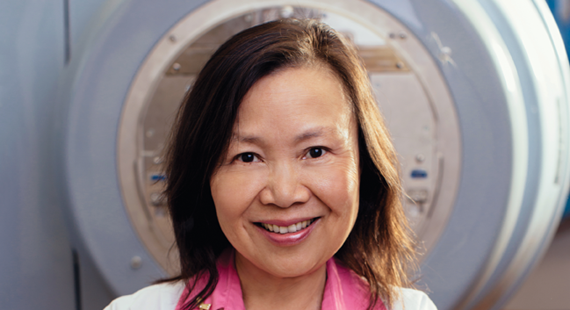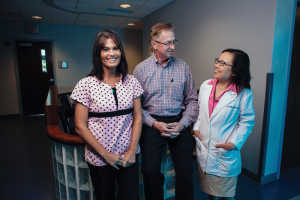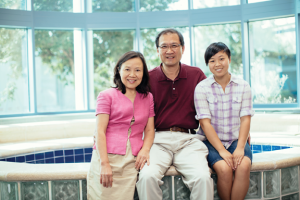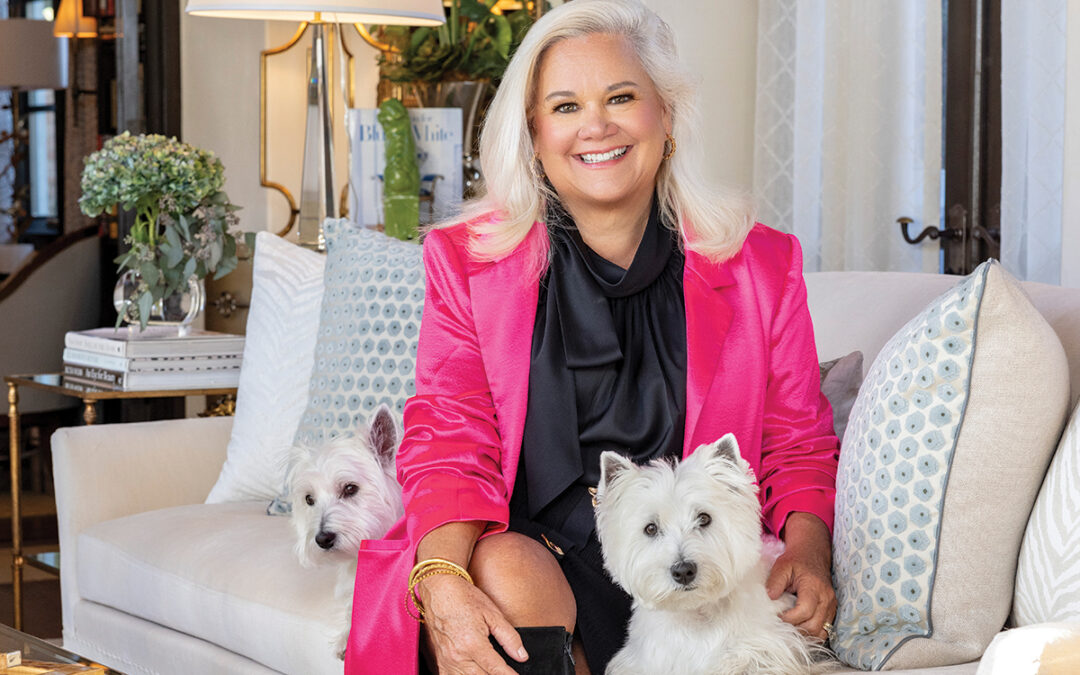
When Marisela Villareal, 46, discovered a lump in her breast in 2010, she lost no time getting to a doctor. Several members of her family had died of cancer, including her mother and two brothers. She was relieved to hear that her lump was benign, but a year later it was still there and causing pain. After a mammogram, the radiologist told her he had seen “something” and wanted her to have a sonogram as well. But her regular doctor didn’t seem to be concerned. He said cancer didn’t hurt. “The same thing happened this year,” she notes. “If there’s something I fear in this world, it’s cancer, so I took it upon myself to go to the Internet to find specialized treatment. I typed in ‘breast cancer clinic,’ and one entry was the Aurora Breast Center in San Antonio. I clicked on that and started reading, and I told myself ‘I need to get there.’”
And she did. In fact, that’s where I have the opportunity to meet her on a late October afternoon just after she has been examined by the clinic’s founder and medical director Dr. Jui-Lien “Lillian” Chou. Though the doctor did not feel the lump during the physical examination, she will not render a diagnosis until Villareal undergoes an MRI scan. Still, she is reassuring. “You can tell your children that if there’s a problem, it will be a small one,” says the petite, friendly physician. Before leaving the clinic, Villareal says she already feels like she’s come to the right place. Another frightened patient gets even better news. This woman traveled from Mexico City to be checked after she had found a lump under her left arm. The doctor invites all of us the patient, her friend and me, the journalist into a darkened room to view the patient’s MRI. “See, it’s beautiful, no cancer,” she announces, looking at the image on the screen where no white spots can be seen. “So, what’s the lump under her arm?” I ask. “Fat,” is the doctor’s short answer. We all smile.
The MRI in question is no ordinary whole-body scanner. It’s an Aurora Dedicated Breast MRI System, developed by Aurora Imaging Technology and Dr. Steve Harms, a well-known physician/scientist in the field of magnetic resonance imaging. Early in his career, Harms worked with Paul Lauterbur, Ph.D., who won the Nobel Prize for the development of MRI. Dr. Chou decided to purchase the $1.2 million machine in 2007 after carefully researching available diagnostic options and following her own bout with cancer (more about that later). It’s the only such instrument in San Antonio. Not only is the imaging resolution much higher than in mammography, but the MRI provides 3-D images of the breasts, the chest wall and the lymph nodes for a complete picture of surrounding tissues. “It saves lives,” she notes. “This MRI represents what I want to do for the community. It’s an investment in the health of the community.”
 Despite successes in breast cancer prevention and treatment, there are still more than 200,000 new cases diagnosed each year in the United States and some 40,000 deaths. Since mammography became widely available, the death rate has been reduced by about 20 percent, says Dr. Chou, but “we want it to be at least 80 percent.” That’s where the dedicated MRI could be helpful. It can detect much smaller abnormalities than what is typically picked up by a mammogram, and it’s especially indicated for women with dense breast tissue. Other women who could benefit from it are patients whose physical examination and mammogram do not point in the same direction and individuals with a number of risk factors, especially if they are over 50 and have a personal or family history of breast, ovarian or colon cancer. “Breast density awareness is important,” states the doctor. “Your physician gets the radiology report but rarely sees the actual mammogram. The density is not disclosed in that report, and yet dense tissue can hide abnormalities, so a mammogram could be useless, but no one tells the patient. That’s one reason mammograms and sonograms detect only 70 percent of tumors; MRI detects 97 percent.”
Despite successes in breast cancer prevention and treatment, there are still more than 200,000 new cases diagnosed each year in the United States and some 40,000 deaths. Since mammography became widely available, the death rate has been reduced by about 20 percent, says Dr. Chou, but “we want it to be at least 80 percent.” That’s where the dedicated MRI could be helpful. It can detect much smaller abnormalities than what is typically picked up by a mammogram, and it’s especially indicated for women with dense breast tissue. Other women who could benefit from it are patients whose physical examination and mammogram do not point in the same direction and individuals with a number of risk factors, especially if they are over 50 and have a personal or family history of breast, ovarian or colon cancer. “Breast density awareness is important,” states the doctor. “Your physician gets the radiology report but rarely sees the actual mammogram. The density is not disclosed in that report, and yet dense tissue can hide abnormalities, so a mammogram could be useless, but no one tells the patient. That’s one reason mammograms and sonograms detect only 70 percent of tumors; MRI detects 97 percent.”
Dr. Chou opened her first breast center in 2001 in Lubbock called Wellness Lubbock and expanded into San Antonio in 2009. As a radiation oncologist, she treats all cancers, not just breast tumors,with a range of therapies and provides a variety of scanning modalities in addition to the breast MRI. In fact, the Aurora consists of three “centers”: Cancer Center, Imaging Center and the Breast Center. The clinic is also known for following up on patients after the conclusion of active treatment. “I saw a need for a continuum of care,” says the founder, “from screening and diagnosis through treatment and followup, all under one roof.”
Dr. Chou commutes between Lubbock and San Antonio, but associate physicians and a Ph.D.-level nurse practitioner, Angelia Berkowitz, are always on the premises. In addition, three radiologists, including Harms, serve as consultants. Other qualified physicians can also practice at the Aurora — and use its hightech equipment — because the facility is “an open-staffed center,” explains Dr. Chou.
She, Too, Is A Cancer Survivor

Born in a small rural community in Taiwan, young Jui-Lien decided early on to pursue medicine as a career. She received her medical degree from the College of Medicine at the National Taiwan University in 1980 and later came to the United States, where she specialized in radiation oncology at the University of Texas Health Science Center at San Antonio. Before the move, she had already married fellow physician Dr. Peter M.T. Ho and had her first baby, but they did not accompany her here. For one thing, her husband wasn’t sold on resettling in the States, and her baby needed more attention than a busy medical resident could give her. “I wanted to do more and learn more,” says Dr. Chou. “Taiwan’s a bit rigid, and the profession is dominated by a hierarchy of male doctors from established families. Also, it’s too small, and I was concerned about China’s threats to take over Taiwan. I was serious about what I wanted to do. I guess I am not a traditional wife,” she concludes with a chuckle.
Fortunately, Dr. Ho changed his mind, and the family was reunited in Texas. Two more children were born in the U.S. as the Hos in 1989 settled in Lubbock, where he joined the Texas Tech Ophthalmology Department and completed his residency. He has been in private practice ever since. Life was good, and Dr. Chou felt that as a physician she was doing the best possible job for her patients. Already thinking in terms of comprehensive care, she made sure that her first clinic had the best diagnostic tools available at the time, and she followed her own advice by getting both a mammogram and a sonogram every December. So when she felt a painful spot on her breast in September 2004, only months after her last mammogram, she was shocked. There was no history of the disease in her family, she was not a smoker, and she followed a healthy lifestyle. “It was such a shock that I cried for two weeks,” she admits. Worse, the pathology report indicated that the cancer might be aggressive and in multiple sites. No MRI was available to her back then to provide a more accurate picture of her breast, so she opted for a mastectomy, followed by months of chemotherapy. And that was not the end of her ordeal. In 2005, as she was hearing more about MRI technology, she decided to have a breast MRI/ whole-body scan (as the specialized breast instrument had not yet hit the market). To her horror, a tumor showed up in her remaining breast. Neither the mammogram nor the sonogram had picked it up. “I was totally worn out from the chemo, and I found myself facing another cancer,” she recalls. “This time I was devastated.” Though she underwent a second mastectomy, that tumor was later revealed to be benign.
“You can see why I am so pro-MRI, especially pro-Aurora system,” says the doctor. In retrospect, she thinks her mastectomies could have been avoided had the more advanced imaging tool been available. Spurred by her own experience, she redoubled her efforts to offer patients early detection and compassionate care. And that includes survivors. The Aurora Foundation, a part of the Ho-Chou Family Foundation, is a nonprofit organization she founded to support and improve the quality of life of cancer survivors. Dr. Chou is also a great believer in healthy eating. As a child she used to join her father and five siblings in growing their own food, so she has transplanted the idea to a 250- acre farm in Lubbock, which grows organic produce to sell to the community and serve as an educational environment for children and adults who want to learn about urban agriculture. “You are what you eat,” she says. “People think they have to go to Timbuktu to plant a garden, but you can do a lot in your yard plant four or five trees, and you’ll have fresh fruit for your family, not to mention that working outdoors is fun, fights depression and provides sun exposure.”
Asked what she is looking forward to, the doctor hardly hesitates: “Being a cancer survivor, you live a day at a time. I am only responsible for today. It’s important to focus on what’s important. God gave me this opportunity to be a cancer doctor, and I consider it fortunate that I had breast cancer because I might not have been as passionate about breast cancer care as I am now, and I might not have acquired the (specialized) MRI that helps so many people.”









0 Comments